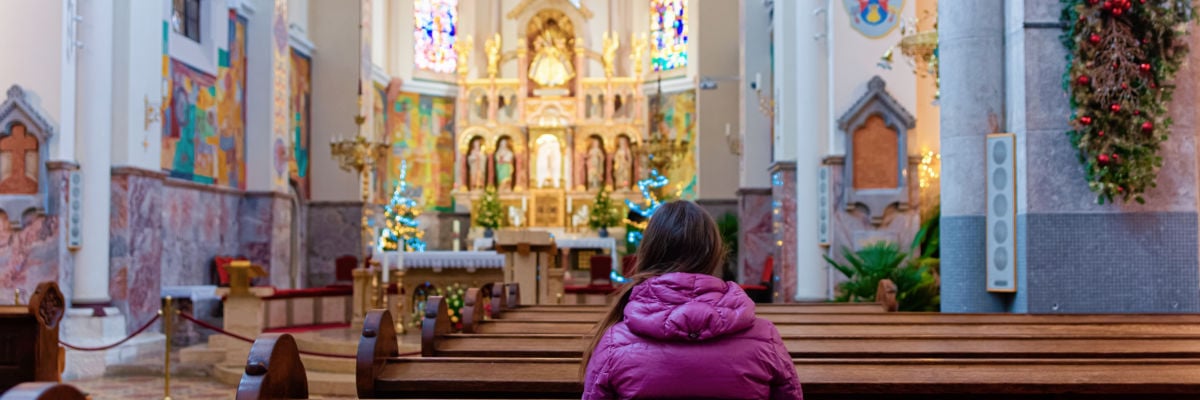
In my experience, church mission statements are usually more trouble than they are worth. What is it that our parish does that the one next door does not? Well, a lot of things . . . and nothing. We may be good at outreach, and our neighbors do beautiful liturgy, but we ought to do better liturgy, and they ought to try a bit harder to help people who don’t show up on Sundays. At the same time, every community has a particular character—a charism, even—and it is worth identifying and developing.
I am agnostic on the question of getting a committee together to craft a fifty-word blurb for the cover of the bulletin. But if a parish does choose to craft and publish a mission statement, the main thing I would counsel is to be careful how it uses the word kingdom, particularly in relation to any version of another word: build.
Talk of building the kingdom has become common among Catholics and Protestants alike, and for the most part, it is well-meaning. No less an authority than St. John Paul II said in a general audience in 2000,
All the just of the earth, including those who do not know Christ and his Church, who, under the influence of grace, seek God with a sincere heart (see Lumen Gentium 16), are called to build the kingdom of God by working with the Lord, who is its first and decisive builder.
Even with non-Catholics, Catholics build. We seek to make the experience of life in the world more fruitful than others, and institutions like schools, soup kitchens, community centers, service organizations, social clubs, and devotional societies are part of this divine construction project.
There is a danger, however, that some Christians will mistake social service for the heart of the gospel of Jesus Christ. Such thinking mistakes the Church as an institution, where grace happens to be available. In this way, the Mass and, by extension, all Catholic liturgy and ritual become utilitarian—at best, the Lord’s body is a pill that infuses our souls with strength to go out somewhere else and make a difference. In the same way, to some people, education is mostly utilitarian, valuable since the contents that we learn may be applied for our own or others’ material gain.
Institutions tend to have utopian or at least progressive ends, even where the institution may have a stated conservative viewpoint. That is, every institution works to create more of something, do more of something, expand its reach, and heighten its influence. The Church’s institutions unabashedly seek these kinds of ends, but the Church itself is not becoming anything else, going anywhere else, or waiting for us to fix it or finish it. The Catholic Church is because Christ is. The kingdom of heaven has already come near, and our participation in the liturgy of the Catholic Church is our experience of the veil separating heaven and earth dropping in our midst.
The Catholic Church is not a theory waiting to be put into practice. Nor is its earthly form a mere shadow of a heavenly reality that is to come. It exists. It is a concrete reality, composed of everyone baptized in the name of the Father, and of the Son, and of the Holy Spirit. It is a people, just as God’s chosen people Israel were and are a people.
Not an institution. Not a box.
The Catholic Church is in quite a bad position today in relation to State and society, masking its true identity and destiny and leaving even its most devoted members at a loss for how to proceed with evangelism.
In the earliest days of the Church, the Jews in Jerusalem who believed that Jesus was their promised Messiah differentiated themselves from other Jews who did not share their view. Although they continued to attend the Temple, eventually, they faced persecution from their kinsmen, as Jesus had foretold in the Gospel according to St. John. In the next few centuries, as the missionary endeavors of Peter, Paul, James, and the rest of the apostolic band spread the Faith throughout the Roman Empire, persecution flared up here and there. But in both directions—toward Judaism and paganism—the Christians knew what they were about. They were a people made up of many peoples, dwelling among many peoples.
As the Church took root in Europe and Christendom was born, being Catholic defined the identity of peoples not as a rebellion, but as a culture—indeed, as civilization. It was obvious to all that the Catholic Church was not an institution, but the wellspring of the moral life of individuals and families and the ground upon which tribes and kingdoms and ultimately modern nation-states stood. In a time and place where everyone was baptized (or almost everyone), there was implicit pressure to create laws, maintain norms, and in every conceivable way organize life around the sacramental life of the Catholic Church, whose cathedrals, monasteries, abbeys, and churches were not accidentally the centerpiece of every city, town, and village. That is, the ubiquity of Church institutions and their power to form individuals signaled the identity of the Church as the transcendent marker of identity that defined the group. Even where—or especially where—individuals were not personally on fire for the gospel, only the mentally deranged or deficient thought society ought to conform to their dissenting view. The assertion of rights within a theoretical religiously neutral space was simply anachronistic.
In recent centuries in the once thoroughly Catholic societies of the West, however, Christianity has fragmented into groups, which we explored earlier, making its various expressions look more like institutions among others in a broadly Christian but officially neutral society. For a long time in countries like the United States and France, secularism still maintained an essentially Christian character. Hence, my own parents remember saying the Lord’s Prayer in their public schools, and no one—including Jews and other religious minorities—objected on the grounds that some fundamental principle of a separation of Church and State was being violated. In this example, the school was obviously the institution, whereas churches were understood to be something more like the guardians and promoters of the values that everyone agreed ought to underpin all institutions.
In the 1960s, however, things began to change. God was banished to the private sphere, and Christian secularism transformed into a non-religious or even anti-religious version of secularism. In Europe and North America, the Catholic Church, along with Protestant communities, came to dwell in a no-man’s-land between where ancient Christians died for the Faith and the everyday Christian reality where medieval and early modern people lived for the Faith. Being an authentic Catholic had always been a choice, but in the late twentieth century, it became only a choice.
The Catholic Church had always had a lot of institutions, but nowadays, it is considered only an institution, even if a holy one.
When a person becomes a Catholic, whether baptized as a child or as an adult, he joins the body of Christ as member of a parish, which is a subtly different thing from a member of a church. Parishes are geographic regions assigned to the pastoral oversight of a bishop, who delegates authority over individual parishes (or sometimes multiple parishes) to his priests. In most cases, the parish church is synonymous with the parish, but, unlike in most Protestant traditions, whether one chooses to go to a local church or prefers an option farther away, that person technically belongs, spiritually, to the physical place where he dwells.
To the untrained eye, the parochial system appears to be about as institutional as anything gets—but in fact, because the parish exists to transform ordinary man into sacramental man, the parish is super-institutional. It is a mark of heavenly citizenship on terra firma. Here we may to the example of ancient Israel, and how the Catholic Church is both the fulfillment and continuation of God’s choice of one chosen nation, one promised land, and one dwelling place on earth in the Temple.
The identity of the Catholic parish is described in the Catechism of the Catholic Church in two different places. In paragraph 2179, we read that “a parish is a definite community of the Christian faithful established on a stable basis within a particular church,” and “the pastoral care of the parish is entrusted to a pastor as its own shepherd under the authority of the diocesan bishop.” If I have not stated it plainly enough throughout this chapter, let me put straight now: the Catholic Church is a people, a people in a place, and a people in every place. But there is one more all-important element, and the Catechism describes it in paragraph 2226: “The parish is the eucharistic community and the heart of the liturgical life of Christian families.”
Eucharistic. Community.
Although there are precisely seven sacraments of the Church, the Church itself has the essential character of an overarching sacrament. It is where the body of Christ receives the body of Christ—where Christ, who is “all in all,” dwells where I am, and also where Christ is present in full to a brother Christian in a faraway parish in a faraway land. As Jesus says, “I tell you, something greater than the Temple is here” (Matt. 12:6).
What we have here, then, is not just one super-institutional focal point for a relatively small nation of God’s people. Nor do we have in the Church merely an institution with a universal spirit of inquiry shared among people in different cities and countries. Rather, the Catholic Church is the experience of the common destiny of man—eucharistic man—transformed into Christ by Christ, living in a present that intersects with eternity. In every parish, in every home, in every institution, and in every heart, Jesus is Lord.
If the Church isn’t an institution, then what is it? A denomination? A club? A religion? No, none of these (not even a religion!). Find out more in The Faith Unboxed, available now in the Catholic Answers shop.



